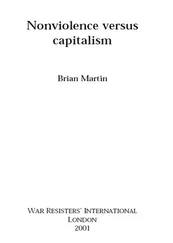All the available evidence shows that human beings have no instinctual urge to physically harm other people. [3] . Jeffrey H. Goldstein, Aggression and Crimes of Violence (New York: Oxford University Press, 1975); Ashley Montagu, The Nature of Human Aggression (New York: Oxford University Press, 1976).
Indeed, cooperation is much more “natural” than competition. [4] . Alfie Kohn, No Contest: The Case Against Competition (Boston: Houghton Mifflin, 1986).
Without day-to-day cooperation, what is called society would be impossible.
Military forces have to work hard to get over the natural resistance that humans have against killing each other. Most people do not want to join armies, hence the need to promote nationalistic fervour and, if necessary, introduce conscription, especially in wartime. To get a person to kill on command — as is required in armies — requires extensive training. To prevent soldiers from fleeing in the face of battle, stiff penalties, including summary execution, are used.
As the standard of living rises, people are less and less willing to be conscripted, and many armies are becoming fully professional. [5] . David Cortright and Max Watts, Left Face: Soldier Unions and Resistance Movements in Modern Armies (Westport, CT: Greenwood, 1991).
In this situation, the main motivation for joining up is no longer compulsion, patriotism or peer pressure, but jobs and careers. When most of those who join do so because they are unable to obtain other jobs, this can be called “economic conscription.”
Another factor is that most members of high-technology armed forces do not engage in face-to-face combat. The vast majority remain behind the lines as planners, mechanics, cooks, accountants and the like. Even many of those who are on the “front line,” such as pilots and tank drivers, do not see the eyeballs of those they are trying to defeat. Killing is much easier at a distance. [6] . Dave Grossman, On Killing: The Psychological Cost of Learning to Kill in War and Society (Boston: Little, Brown, 1995).
On the front line, soldiers may kill because they have been trained to do so, to protect their buddies, to maintain their self-image or out of fear of being killed themselves. Dehumanisation and hatred of the enemy make this easier. They also make it easier to rally civilians behind the military effort. Commanders — both politicians and military chiefs — regularly create fear about the danger from the enemy. Aggression by the “other side” is used as a justification for retaliation, even if the “retaliation” is vastly disproportionate to what preceded it. German Führer Adolf Hitler, in justifying the invasion of Poland in 1939, created a fabricated attack by Polish troops. US President Lyndon Johnson in 1964 used the alleged Tonkin Gulf incident in Vietnam as the excuse for a massive mobilisation of US troops.
These examples illustrate that violence often provides the justification for counterviolence. When one group or one country uses violence, the other side feels justified in using violence in return, thereby justifying the original violence. This process is behind the familiar idea of military races. In the case of violence, the principle of fighting fire with fire simply leads to a bigger fire.
Nonviolent action challenges and undermines the cycle of violence. If one side in a struggle renounces violence, then soldiers on the other side need not fear for their lives. As well, the justification for violence is greatly weakened. This means that it becomes much harder for the commanders on the side still authorising the use of violence to actually get soldiers to obey orders to use it.
One of the most famous uses of nonviolent action was the struggle for independence of India from Great Britain, waged under the leadership of Mohandas K. Gandhi. This struggle went on for several decades until independence was achieved in 1947. Some of the methods used were rallies, marches, boycotts of British textiles, Indian production of cloth in villages as a symbol of autonomy, and civil disobedience to laws prohibiting manufacture of salt. On the Indian side, the independence campaign was largely, though not entirely, nonviolent. The British, in turn, did use violence at times — there were some major massacres of unarmed civilians, and thousands of Indians killed overall — but were remarkably restrained.
Many people attribute this restraint to the British being particularly kind colonialists. Other evidence suggests a different view. In Kenya, another British colony, the independence movement in the 1950s — called the Mau Mau rebellion — had an armed wing. British settlers carried out the most dreadful violence on the native Kenyans, perpetrating massacres and setting up dozens of concentration camps in which anyone suspected of being a Mau Mau was liable to be tortured relentlessly, leading to numerous deaths. [7] . Robert B. Edgerton, Mau Mau: An African Crucible (New York: Free Press, 1989).
The obvious explanation for the difference between British behaviour in India and in Kenya is that the limited armed struggle by the Mau Mau provided a justification for massive British violence. By maintaining nonviolent discipline, the Indian independence movement inhibited British violence. [8] . This comparison of India and Kenya was made by Robert J. Burrowes, The Strategy of Nonviolent Defense: A Gandhian Approach (Albany, NY: State University of New York Press, 1996), p. 239.
In both cases, a key element was public opinion in Britain itself. Within both India and Kenya, more violence might have been used against the independence movements except for the political repercussions back home. Massacres of unarmed civilians in India caused outrage within Britain. However, massacres in Kenya created less impact because the struggle was — and was seen to be — violent on both sides. Even so, when reliable reports of extensive torture and deaths in Kenyan concentration camps became known in Britain, this was a key factor in the granting of independence. Significantly also, many British troops and commanders in Kenya were appalled at the violence perpetrated by the British settlers.
Nonviolent campaigns are largely struggles for loyalties. First is the loyalty of the people waging the nonviolent struggle, such as the Indians under British rule. Initially, only some may support the struggle and only a few may be willing to take a stand. Using only nonviolent methods allows others to join in, since anyone can participate in nonviolent actions, unlike armed force where young fit men are the main participants. If the other side uses violence against the nonviolent resisters, this is likely to create outrage in the community and generate increased support.
When the Palestine Liberation Organisation endorsed the use of violence to oppose Israeli rule in the occupied territories, this limited the degree of support from the Palestinians themselves. Only a few Palestinians participated in secretly organised violent acts, often against civilians — commonly called “terrorism” [9] . Terrorism as normally defined refers only to small nonstate actors. Arguably, terrorism on a far larger scale is carried out by governments. See for example Edward S. Herman, The Real Terror Network: Terrorism in Fact and Propaganda (Boston: South End Press, 1982).
— intended to overthrow Israeli military occupation. In 1987, a spontaneous unarmed opposition to Israeli rule developed, called the intifada. Independent of the PLO, it involved rallies, vigils, strikes, tax refusal, boycotts of Israeli businesses, shop closing, self-sufficiency through local gardens, home-based schooling when schools were shut down, and many other tactics. Many Palestinians threw stones at Israeli soldiers, but otherwise almost all the methods used were nonviolent. The range of nonviolent methods used meant that everyone could be involved, for example by observing a boycott. As a result of the nonviolence of most of the methods, many more Palestinians became involved in the intifada than had ever been involved in terrorism, and many more Palestinians supported the resistance than before, for example including rich Palestinians. [10] . Souad R. Dajani, Eyes Without Country: Searching for a Palestinian Strategy of Liberation (Philadelphia: Temple University Press, 1994); Andrew Rigby, Living the Intifada (London: Zed Books, 1991).
Читать дальше












